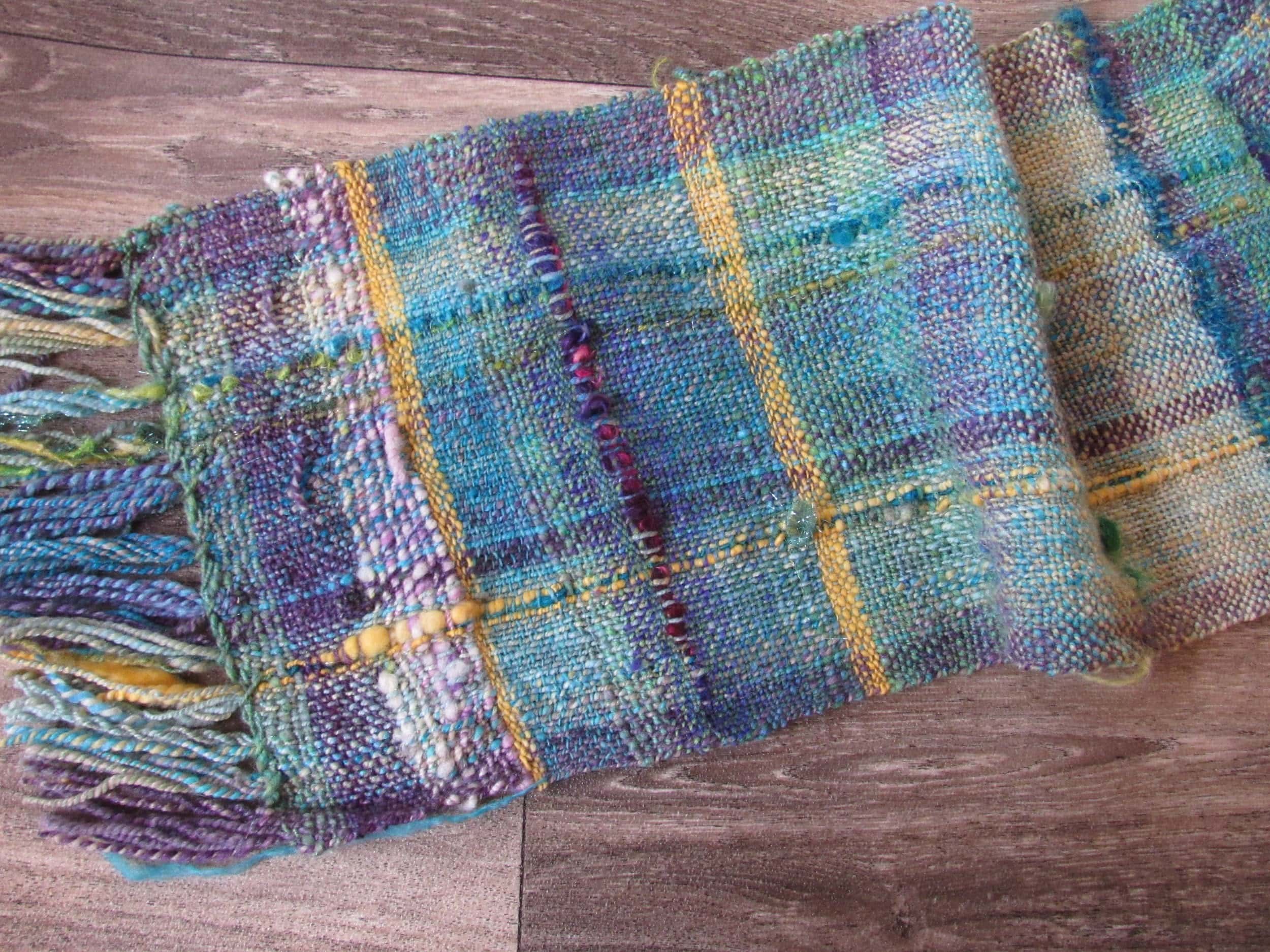By Debbie Held
If you are an avid fiber crafter, there’s a good chance that you’ve taken notice of weaving and the incredible surge in popularity this craft has been experiencing. Perhaps you’ve even dipped a toe in the water, having purchased a small rigid heddle loom for yourself before you order that special floor loom. Soon, you think, you’ll be freeform weaving Saori-style, just like the pros you see on Instagram.
Well, here’s a little known fact: Saori-style, freeform weaving can be done on any kind of loom, and the Cricket Loom is the perfect vehicle for delving into all of your own freeform and Saori-based weaving experiments.
What Is Saori?
This free-style form of weaving, which originated in Japan, is all about exhibiting one’s true self through expressive, no-rules weaving. Saori, which means a process to uncover the hidden power of creativity, was founded by Misao Jo, who discovered through a missed warp thread that there is unique human value in a non-machine-like fabric.
Saori is based on the Japanese aesthetic of Wabi-Sabi, or the acceptance of imperfection. Whatever is woven is perfect as it is: broken and repaired warp threads, lumpy selvedges, whatever … These irregularities represent the uniqueness of human-made woven cloth as compared to a “perfectly” woven cloth. Imperfections, on all levels, are to be embraced.
Most of all, Saori encourages the inclusion of anyone who wishes to weave.
As a new weaver myself, exploring free-style weaving using my 15-inch Cricket rigid heddle loom has allowed me to learn by doing, without fearing results which may be somehow “wrong.”

When I first posted the photos of my orange scarf on my various social media platforms, I received dozens of questions from other Cricket owners asking for specifics on how I came to create this exact scarf. Here’s the thing: It cannot be reproduced; it is one of a kind, created from 100 percent handspun yarns at a specific point in time. However, after speaking with the nice folks at Schacht Spindle Company, we decided that a “Freeform Cricket Loom Scarf” was in order to help owners of rigid heddle looms learn to feel more comfortable with their own weaving.
Selecting Yarn and Heddle Size
While I weave exclusively with my own handspun yarns, freeform weaving can and should be accomplished with almost any commercial yarn you have on hand. You may even mix yarn weights together if your heddle/reed is spaced accordingly to support the size of your yarn, though for a first project I would recommend dramatic differences in yarn size be left for weft (weaving side to side) and not for your warp.
Both the 10-and 15-inch Crickets come with an 8-dent heddle, but this recipe works equally well with the 10-dent (which has more slots/holes per inch and yields a slightly lighter weight fabric) and of course with the variable dent reed.
Building a Color Palette
For assured visual success, create a color palette. Select a main color (MC) from one favorite skein of fingering–DK-weight yarn, and then add to your color scheme from there.
You'll need:
- 1 (3.5 oz) skein of fingering-DK-weight yarn in your main color (MC); tonal, semi-solid or solid being ideal.
- 1–2 skeins (3.5 oz total, so partial skeins are fine) of coordinating colored (CC) yarns, featuring a darker or lighter version of your MC plus at least one more additional color; color repeats are ideal, e.g. speckles, space-dyed, even self-patterning repeats.
- several yards of one color pop (CP) yarn, something that stands out against your other yarns/colors
- bits and pieces of yarn from stash with some “extra textural personality” (think: novelty yarn, ribbon yarn, eyelash, etc. You know you still have some...) in MC, CC and/or CP. You’ll only need a few yards of each.

Not so great with color, you say? Fear not! Here are some easy ways to feel more confident in your color-gathering results:
- Trust your yarn stash and the dyers who helped you to cultivate it. Base your choices off of what you already love.
- Think of a simple theme and go with the colors it makes you think of (blues in winter; reds and oranges in fall; greys on a rainy day; etc.).
- Look at an online color wheel for added assistance.
- Try going monochromatic, using varying shades/hues of your MC and letting yarns with texture do all the work.
- If you’d rather weave with two colors, weave with two colors. It’s your weaving!
Warping the Loom
If you’re new to warping a rigid heddle loom, this 3-minute video from Liz Gipson is remarkably concise and clear. I have a 15-inch Cricket, and I like my scarves warped at around 10–12 inches wide, so I tie on 1.5–2.5 inches from one side and simply work across my apron bar until I’m the same distance away from the other side. (If you’re using a 10-inch Cricket or another, narrower rigid heddle loom, go ahead and warp the entire width, unless you want a narrower scarf.) I clamp my warping peg to a bar stool and set it at 90–95 inches away from my working table, measuring from the back of the loom.

If you are comfortable with warping, tie on a second color—any from your palette—off-center, toward one side of the warp. Just eyeball it. Warp one or two slots with this second color, then tie it off and return to using your MC.
While you should have more than enough yarn for this particular project, remember that with freeform weaving there are no “mistakes”—not as one would normally consider them. Make do. You have plenty of yarn in your color collection.
Freeform Weaving
Finally, the best part: weaving.
Weave freely, inspired by your yarn selection, your mood, the weather. Try not to be too stringent about yarn placement nor about order of use, especially. Vary the order in which you weave your colors and stagger the number or rows or inches you weave with each. Every here and again, vary the yarn size (if such a choice is among your yarn selection), texture, and so on. Experiment to your heart’s content.
For added zing, leave a few ends dangling when you are switching yarns, then come back and add beads to some of them (or just leave them plain) during finishing. I like to hemstitch the beginning and end of my weaving.
When you can’t weave any further, remove your weaving from the loom. Finish it by soaking in a tepid bath with wool-safe wash, roll it in a towel to remove excess water, and then lay or hang to dry. Don’t be surprised to see shrinkage of approximately 10 percent. Trim your fringe using sharp scissors. (I like my fringe about 3 inches long.)
(Please note: the texture in my scarves is made up mainly from the inclusion of dyed sheep locks. I just wove them right into my fabric.)
There is simply no better way to learn any new skill than by learning through doing. As a newer weaver and an insatiable spinner, I have found my 15-inch Cricket loom to be the jelly to my handspinning’s peanut butter: delicious apart, but even more perfect together.
To learn more about SAORI weaving visit https://www.saoriglobal.com/about
For more color theory information, check out this great guide on color: https://www.jenreviews.com/color-meaning/

